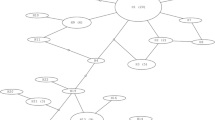Abstract
Research on cystic echinococcosis (CE) has a long history in Kenya, but has mainly concentrated on two discrete areas, Turkana and Maasailand, which are known to be foci of human CE in Africa. Here, we report on a survey for CE in livestock from central to northeastern Kenya, from where no previous data are available. A total of 7,831 livestock carcasses were surveyed. CE prevalence was 1.92 % in cattle (n = 4,595), 6.94 % in camels (n = 216), 0.37 % in goats (n = 2,955) and 4.62 % in sheep (n = 65). Identification of the parasite was done using an RFLP-PCR of the mitochondrial nad1 gene, which had been validated before against the various Echinococcus taxa currently recognized as distinct species. From a total of 284 recovered cysts, 258 could be identified as Echinococcus granulosus sensu stricto (n = 160), E. ortleppi (n = 51) and E. canadensis (n = 47) by RFLP-PCR of nad1. In cattle, fertile cysts occurred mostly in the lungs and belonged to E. ortleppi (31 of 54), while the vast majority were sterile or calcified cysts of E. granulosus s.s.. Most fertile cysts in camels belonged to E. canadensis (33 of 37); sterile or calcified cysts were rare. Goats harboured fertile cysts of E. ortleppi (n = 3)—which is the first record in that host species—and E. canadensis (n = 1), while all cysts of E. granulosus were sterile. Only sterile cysts were found in the three examined sheep. Typically, all cysts in animals with multiple infections belonged to the same species, while mixed infections were rare. Our data indicate that the epidemiological situation in central to northeastern Kenya is clearly different from the well-studied pastoral regions of Turkana and Maasailand, and the apparently low number of human CE cases correlates with the infrequent occurrence of E. granulosus s.s.

Similar content being viewed by others
References
Ahmed ME, Eltom KH, Musa NO, Ali IA, Elamin FM, Grobusch MP, Aradaib IE (2013) First report on circulation of Echinococcus ortleppi in the one humped camel (Camelus dromedaries), Sudan. BMC Vet Res 9:127
Alvarez Rojas C, Romig T, Lightowlers MW (2014) Echinococcus granulosus sensu lato genotypes infecting humans—review of current knowledge. Int J Parasitol 44:9–18
Casulli A, Zeyhle E, Brunetti E, Pozio E, Meroni V, Genco F, Filice C (2010) Molecular evidence of the camel strain (G6 genotype) of Echinococcus granulosus in humans from Turkana, Kenya. Trans R Soc Trop Med Hyg 104:29–32
Dinkel A, Njoroge EM, Zimmermann A, Walz M, Zeyhle E, Elmahdi IE, Mackenstedt U, Romig T (2004) A PCR system for detection of species and genotypes of the Echinococcus granulosus-complex, with reference to the epidemiological situation in eastern Africa. Int J Parasitol 34:645–653
Eckert J, Thompson RC, Michael SA, Kumaratilake LM, El-Sawah HM (1989) Echinococcus granulosus of camel origin: development in dogs and parasite morphology. Parasitol Res 75:536–544
Eckert J, Thompson RC, Lymbery AJ, Pawlowski ZS, Gottstein B, Morgan UM (1993) Further evidence for the occurrence of a distinct strain of Echinococcus granulosus in European pigs. Parasitol Res 79:42–48
Hüttner M, Nakao M, Wassermann T, Siefert L, Boomker JD, Dinkel A, Sako Y, Mackenstedt U, Romig T, Ito A (2008) Genetic characterization and phylogenetic position of Echinococcus felidis (Cestoda: Taeniidae) from the African lion. Int J Parasitol 38:861–868
Hüttner M, Siefert L, Mackenstedt U, Romig T (2009) A survey of Echinococcus species in wild carnivores and livestock in East Africa. Int J Parasitol 39:1269–1276
Kagendo D, Magambo JK, Agola EL, Njenga SM, Zeyhle E, Kakundi EM, Njeru PG, Mbae C, Muchiri EM, Wassermann M, Kern P, Romig T (2014) A survey for Echinococcus spp. of carnivores in six wildlife conservation areas in Kenya. Parasitol Int 63:604–611
Macpherson CNL, Craig PS, Romig T, Zeyhle E, Watschinger H (1989) Observations on human echinococcosis (hydatidosis) and evaluation of transmission factors in the Maasai of northern Tanzania. Ann Trop Med Parasitol 83:489–497
Magambo J, Njoroge E, Zeyhle E (2006) Epidemiology and control of echinococcosis in sub-Saharan Africa. Parasitol Int 55(Suppl):S193–195
Nakao M, Sako Y, Ito A (2003) Isolation of polymorphic microsatellite loci from the tapeworm Echinococcus multilocularis. Infect Genet Evol 3:159–163
Nakao M, Lavikainen A, Yanagida T, Ito A (2013a) Phylogenetic systematics of the genus Echinococcus (Cestoda: Taeniidae). Int J Parasitol 43:1017–1029
Nakao M, Yanagida T, Konyaev S, Lavikainen A, Odnokurtsev VA, Zaikov VA, Ito A (2013b) Mitochondrial phylogeny of the genus Echinococcus (Cestoda: Taeniidae) with emphasis on relationships among Echinococcus canadensis genotypes. Parasitology 140:1625–1636
Romig T, Omer RA, Zeyhle E, Hüttner M, Dinkel A, Siefert L, Elmahdi IE, Magambo J, Ocaido M, Menezes CN, Ahmed ME, Mbae C, Grobusch MP, Kern P (2011) Echinococcosis in sub-Saharan Africa: emerging complexity. Vet Parasitol 181:43–47
Wachira TM, Bowles J, Zeyhle E, McManus DP (1993) Molecular examination of the sympatry and distribution of sheep and camel strains of Echinococcus granulosus in Kenya. Am J Trop Med Hyg 48:473–479
WHO (2013) Sustaining the drive to overcome the global impact of neglected tropical diseases: second WHO report on neglected diseases. World Health Organization, Geneva
Acknowledgments
The study was done in the context of the collaborative network ‘Cystic Echinococcosis in sub-Saharan Africa Research Initiative (CESSARi)’, funded by the Deutsche Forschungsgemeinschaft (DFG) (RO3753-1/1, -2/1, KE 282/7-1, -8/1). We also wish to acknowledge the Director of the Kenya Medical Research Institute (KEMRI) for facilitating the lab work for this study.
Author information
Authors and Affiliations
Corresponding author
Rights and permissions
About this article
Cite this article
Mbaya, H., Magambo, J., Njenga, S. et al. Echinococcus spp. in central Kenya: a different story. Parasitol Res 113, 3789–3794 (2014). https://doi.org/10.1007/s00436-014-4045-z
Received:
Accepted:
Published:
Issue Date:
DOI: https://doi.org/10.1007/s00436-014-4045-z




